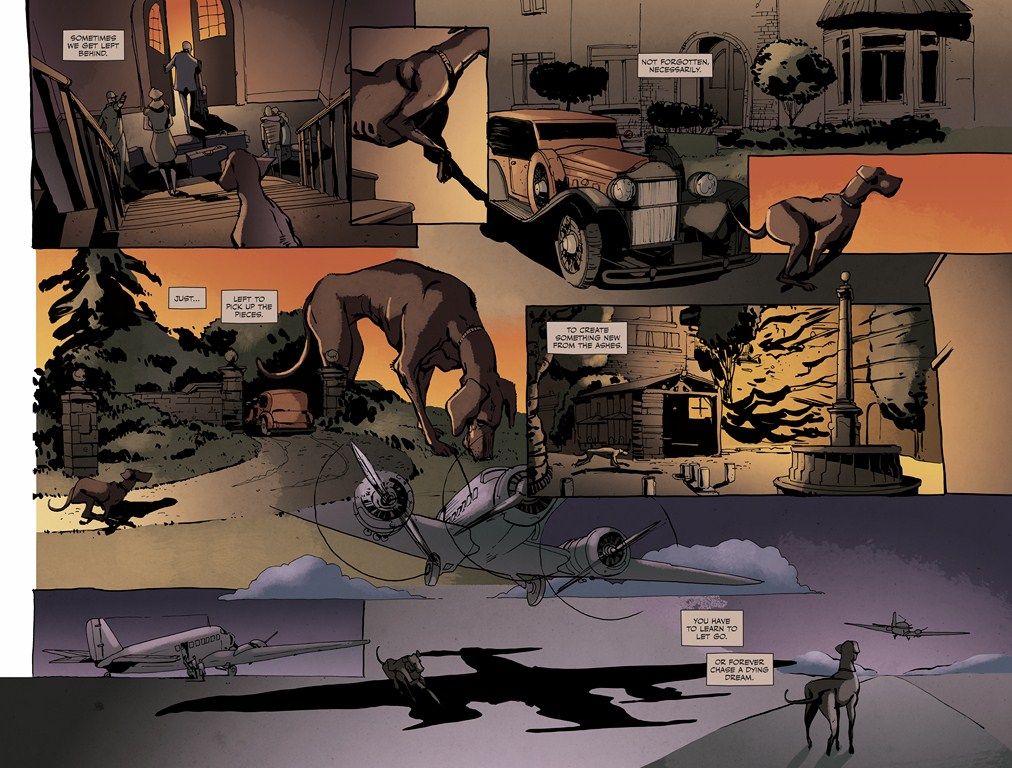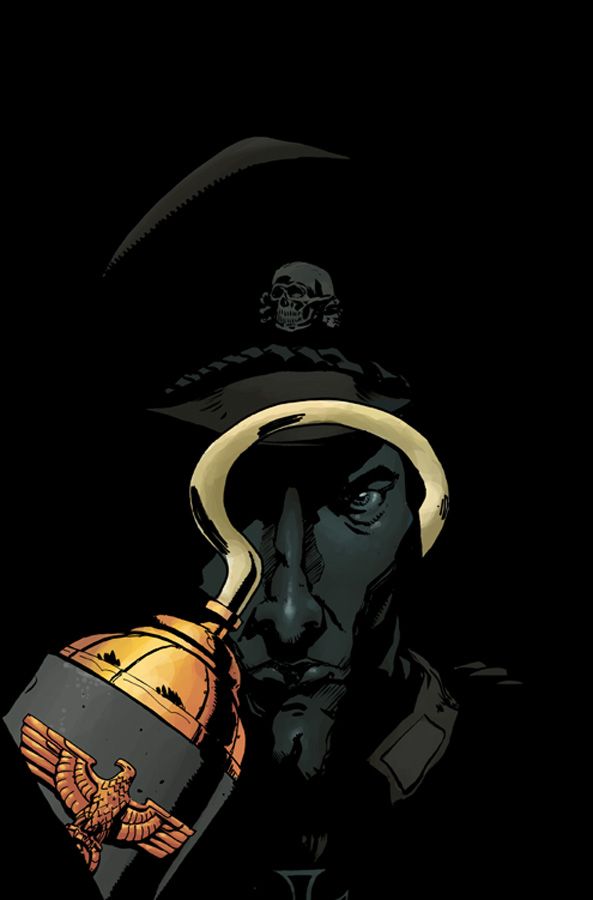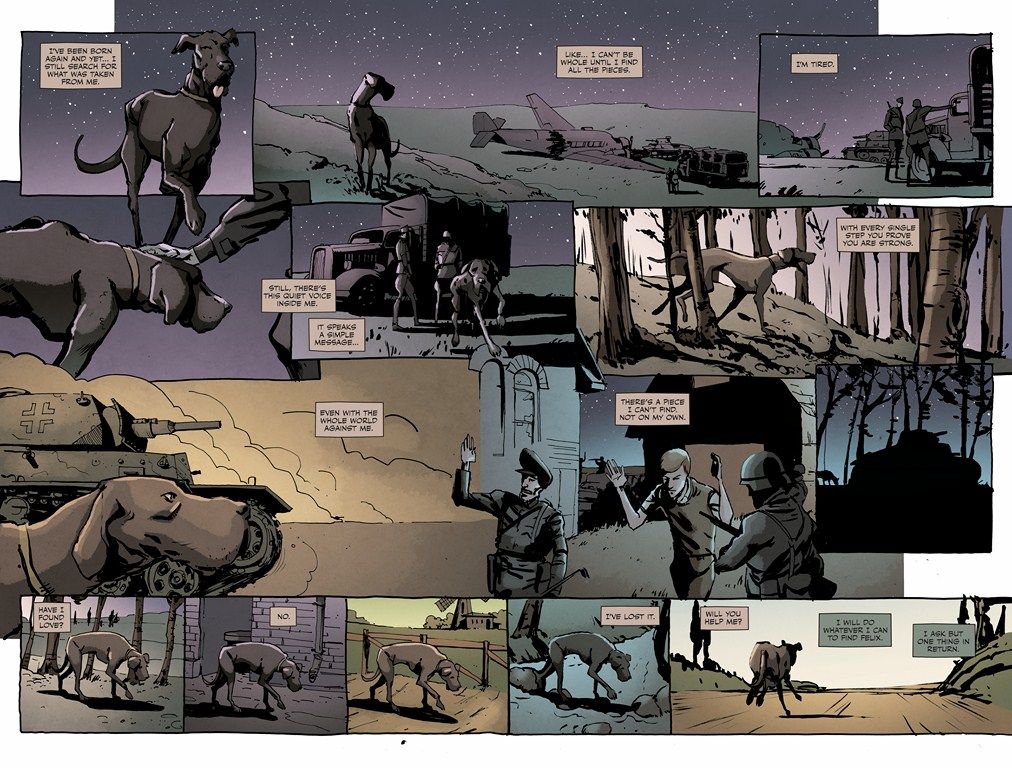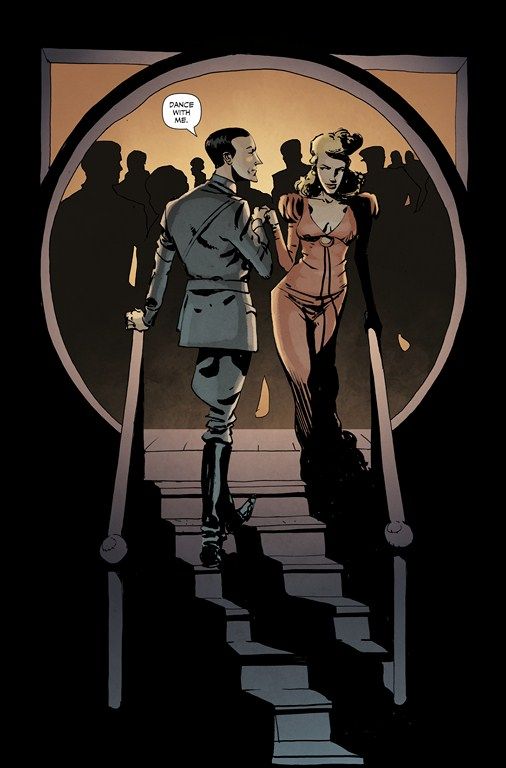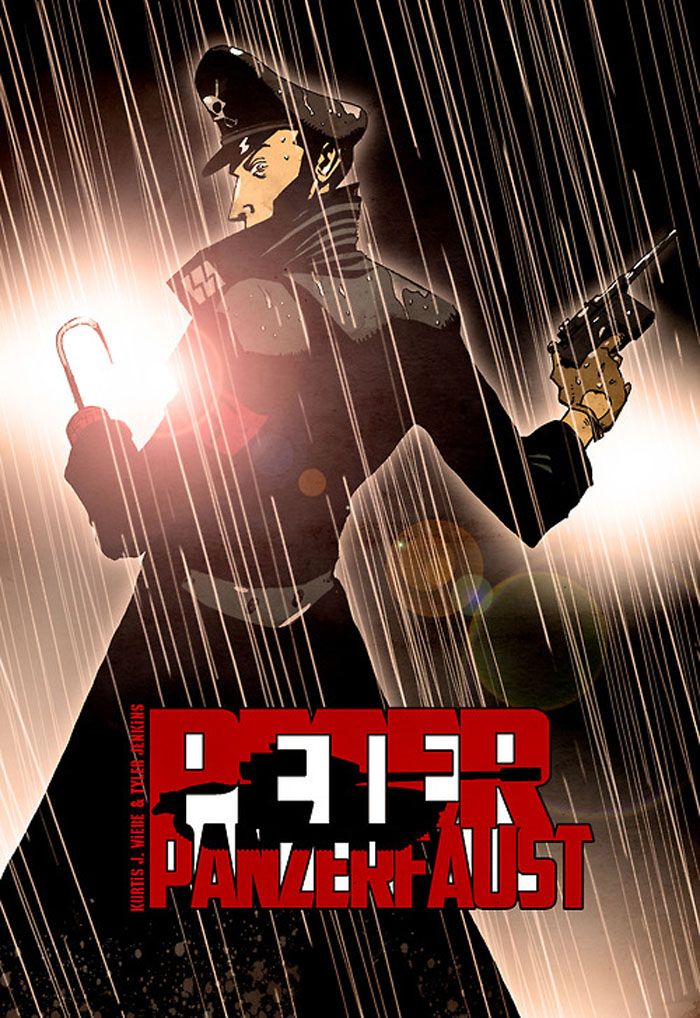Peter Panzerfaust, the wartime reimagining of J.M. Barrie's classic tale by Kurtis J. Wiebe and Tyler Jenkins, has an irresistible hook (if you'll pardon the expression): "Peter Pan versus the Nazis." That's perhaps what drew the attention of BBC Worldwide and Quality Transmedia, which are developing a motion comic based on the Shadowline/Image Comics series, with an eye toward a live-action adaptation.
However, there's more to Peter Panzerfaust than a high-concept log line. Although the title, which debuted in February, has been characterized as historical fantasy, Wiebe and Jenkins have stripped away the fantastical elements -- to date, there are no fairies or bird-nest boats -- with Neverland replaced by France during the 1940 German invasion. Here, Barrie's Boy Who Wouldn't Grow Up is recast as a cocky and charismatic American teenager who rescues a group of orphans in war-torn Calais, transforming these Lost Boys into a rag-tag group of freedom fighters. They quickly added to their ranks the three Darling children, themselves orphaned in a plane crash, before joining up with Tiger Lily, Big Chief and the Braves, members of the French Resistance.
With Issue 8, in stores Jan. 9, arrives the iconic antagonist Captain Hook, whom Wiebe and Jenkins have re-envisioned as Kapitan Haken, the Nazi SS officer tasked with crushing the Resistance. Eagle-eyed readers will recall that Peter briefly crossed blades with Haken in Issue 3, stabbing the officer through the hand (presumably explaining the appearance of the trademark hook). He pledged that Peter would "live to regret this day," and now he appears ready to follow through on that threat.
ROBOT 6 spoke with Wiebe and Jenkins about the development of Peter Panzerfaust, the decision to set the series against the backdrop of World War II, their refreshing take on Tiger Lily, and the major role for Captain Hook.
Robot 6: Peter Pan is very much about prolonging childhood, and innocence, while the circumstances of Peter Panzerfaust require the characters to grow up far too fast. Those would seem irreconcilable, but it somehow works. What was it about World War II, or any war, that made it the right backdrop for your retelling?
Kurtis J. Wiebe: Peter Pan is a story of childhood whimsy, about the time in our life where we faced no responsibility and one day was as magical as the next. The classic by Barrie encapsulated all of our fantasies we loved as children: cowboys and Indians, pirates, flying!
As children, especially young boys, we always make believe war, pretending we’re brave soldiers fighting the good fight. I think there was something interesting about taking that innocence, the feeling of war being a game, and slamming it into the real face of war. World War II worked thematically much better than in other eras simply because in that time the villain was always clear. We didn’t want this to be a political statement, but a story about being forced to change in a time when there was no room for fantasy.
Although J.M. Barrie’s work is usually thought of as lighthearted, it’s tinged with melancholy, which is something you’ve been able to capture in Peter Panzerfaust. Was that something you set out to do, or is that simply a result of the wartime setting and the wistful narration?
Wiebe: Back to my earlier point, I think it’s a natural correlation between the novel and our adaptation. In the novel, there was a subtle sense of loss by the Lost Boys, having forgotten their lives in the real world by avoiding growing up. That was very much a theme in the first arc, “The Great Escape.” By playing at war, by running from the reality of their situation, Peter and the Lost Boys suffered very real tragedy. It was not only a way of grounding our series in an honest picture of what happened to children caught in the conflict, but also as a means to propel them to greatness. To rise above their fear and embrace their fate and, leading into the second arc, saving their captured friend, Felix.
While the 20-foot leap from building to building in the first issue might be labeled “fanciful,” that’s the closest the series has come to fantasy. Was there ever a temptation to sprinkle a little magic throughout the story, or were you always set on playing it straight?
Wiebe: We haven’t quit playing with the fantasy yet. I always knew that the more magical elements of the story were attached to the filter of the person telling the story. Gilbert, or Tootles, viewed Peter in that sort of mythical light, like he was a boy capable of things beyond human capacity. In the second arc, Julien adds his voice and memories to the story in a much more direct, factual way because that is exactly the type of man he is. With the remaining three arcs, each new interviewee will have a profound impact on the way Peter appears in the series.
Each version of Peter (yours and the original) is as charismatic as he is reckless, thrusting the others into danger while also protecting them. But we glimpse in Issue 5 that Peter’s carefree nature may be a façade. Will we see more of the “real” Peter?
Wiebe: Without a doubt. What I hinted at in that final issue of “The Great Escape” is tied into Peter’s history, about why he acts in such a brazen, sometimes reckless way. He carries the hopes and morale of all the boys on his shoulders and he knows that never giving up hope is the key to survive. But, there’s a cost and that side of Peter, the weight of his choices, begin to show through.
From the moment she’s introduced on the final page of Issue 6, Tiger Lily turns the story on its head. She’s a show-stealer, and (thankfully) completely unlike her original depiction. Can you talk a little about her creation, both in terms of character and design?
Wiebe: Thank you! Tiger Lily has been an absolute blast to write and she’s definitely taken over as my favorite character so far. We always knew we wanted to have a very First Nations look to her (that’s the Canadian version of Native American, for the record) and when I wrote up the series outline, I always knew that she’d be half First Nations. This is tied into her history, especially in regards to her father and why he’s in Paris. I’m dealing a lot with legacies in this series and Tiger Lily is no exception.
Her personality sort of came about rather unexpectedly. I knew she was going to be a firecracker but when she shared the scene with Julien (Curly) it was so charged and I found her voice right away.
The three Darling children have largely lurked in the background since they were rescued from the plane crash in Issue 3, but it’s clear that Wendy at least is poised to take the stage in Issue 8. Will we see the Darlings take on a larger role as the series progresses? And while we’re on the subject, what was the thinking behind using the Lost Boys as the readers’ entry into this world rather than the Darlings?
Wiebe: Wendy is going to be a very crucial emotional crux for the series as it progresses and we hint very strongly at it in the upcoming Issue 8. The loss of her parents is a major motivation for her, and in the opening sequence of the issue we really hear her thoughts about it for the first time. From there, her connection to Peter and the Boys takes on a whole new meaning, and I’m slowly building her arc in the background. It’s very intentional. As for her brothers, John and Michael, there will be some answers to their fate at the end of this second arc.
As to why I chose to tell the story from Peter and the Boys’ perspective, it ties into what I said earlier about boys playing soldiers. I’m working with so many themes we face as young adults, from loss to puppy love and then adding in an aspect most of us have thankfully have never had to experience: war.
Issue 8 also sees the introduction of Hook, who’s teased in the back matter of the trade paperback. He’s such an iconic villain, and certainly one of the all-time great antagonists of literature. How do you approach reimagining a character that readers can so easily picture in their own minds?
Wiebe: On a characterization front, it was an easy transition. Hook in the novel isn’t quite the fool the Disney movie painted him to be. He was a monster, obviously still aimed at a younger audience, but is a very scary and threatening presence. How much scarier would it be to put him in a modern era with the might of the entire German army behind him? It was clear from the outset that he’d be an officer in the elite SS and, seeing as Peter and the Boys would eventually join the French Resistance, would naturally be tasked with hunting them down.
Tyler Jenkins: Interesting that you say he can be so easily pictured in people’s minds, because truthfully, he came to me as easily, look-wise. His character drew itself. He was there … in my imagination. I only struggled with whether to give him a mustache or not -- I love drawing mustaches.
What can you tell us about your version of Hook? Can we expect him to play the part of the central antagonist through the planned end of the series with Issue 25?
Wiebe: He’s going to be around for the entirety of the series and will present a very dangerous threat to the adventures of Peter and the Lost Boys. In Issue 9 we get to see a clear picture of this version of Hook and why he’s inextricably tied to Peter’s fate. As I mentioned earlier, I’m dealing with the idea of legacies, how we inherit responsibilities from those that came before us and how we create them for ourselves. All of these tie into the conflict that will be Peter versus Hook.
Tyler, what’s been the greatest challenge in drawing Peter Panzerfaust?
Jenkins: The greatest challenge has been noted gently and less gently in many reviews, that a few of the Boys, or all of the Boys depending on the person, look alike or even identical. To answer that question once and for all: It was actually partially intentional, to have them be quite similar at first, and then as their adventures and experiences change them they become more dissimilar and unique. Looking at photos of boys from most generations at that age, the need to fit in and look like everybody else makes most kids nearly carbon copies of each other. As they mature and grow and discover how they want to be see individually, their looks start to separate. Our Boys will get more and more individual as we go. Note: Two of the boys, Claude and Maurice, are actually twins. So, the challenge in fact was to lay the groundwork for them to become more individual down the line, but still keep them a little different at the beginning. It appears that I may have been far too subtle!
There was Tiger Lily and a sly nod to the mermaids in Issue 6, now Hook in Issue 8. And I understand we’ll see the crocodile at some point. Can you offer any hint as to what form it will appear?
Wiebe: The crocodile appears. How, when and why ... my lips are sealed.

